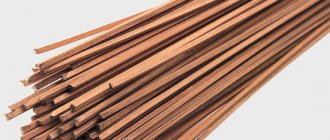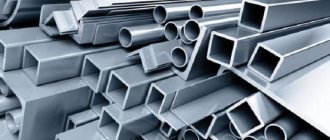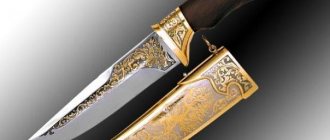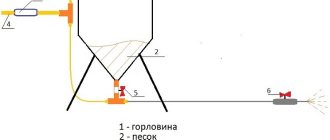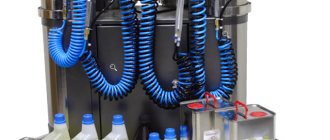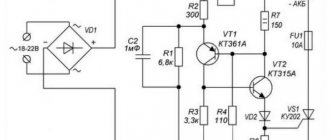Rules for executing schemes
The execution of graphic images of kinematic diagrams is carried out using the following rules:
- choosing the correct designation for the design used;
- precise indication of the location of a separate part;
- the sequence of their interaction;
- line width (set by existing standards);
- correct display of footnotes;
- applying the necessary inscriptions and symbols.
The rules for executing kinematic diagrams consist in describing the following structural units:
- individual elements;
- lines of kinematic connections;
- links;
- kinematic pairs (combine two or more elements).
The developer has the right to choose the scale at his own discretion. This is permitted by approved standards. The drawing may not comply with the actual arrangement of structural components in the unit body.
A block (device, unit) is considered a separate component of the circuit. It is designed to perform certain functions. Its peculiarity is that it cannot be divided into smaller parts without losing its functionality. Such elements are: a set of gears, one or more shafts, installed bearings, and an electric motor used.
The connection line between parts is indicated by a segment of a given length and thickness. It indicates the presence of a communication mechanism between individual products or devices. If this connection is made rigidly enough, the structure is combined into a link. The combined parts and links into a single whole is called an installation.
For a more detailed description of the interacting elements or links, transmission of the direction of movement, it is possible to combine them into so-called kinematic pairs. The features and order of execution of graphic images depend on their purpose.
Functional diagrams display individual design parts that are involved in the main process of motion transmission. For convenience (if possible), several parts are combined into separate functional groups. The drawing must show their functional connections. Each of them has its own graphic symbol. It is established by existing standards and rules for the design of drawings. For a better understanding of the ongoing technological process, it is recommended to plot the technical characteristics of the components used. In addition to explanatory notes, it is allowed to place a sheet of tables or diagrams on a free space.
Schematic diagrams show parts or their groups. These could be shafts, transmission mechanisms or a finished engine. They give an idea and understanding of the operating principles of the entire unit used. Each part or node is depicted in a disabled state (without indicating the order of interaction with other parts). They are compiled to carry out adjustments and debugging of the assembled unit. For this purpose, all basic kinematic connections are depicted: mechanical and non-mechanical. These connections are drawn between individual elements, kinematic pairs or groups of elements. Graphically, they are located within the boundaries of the contour indicating the body of the unit. The drawing of each mechanism, consisting of several components, can be executed in a separate document. A corresponding link is made on the main sheet. If several identical parts are used as part of a separate unit or a whole device, one drawing is allowed. The rest are depicted with acceptable simplifications. The position of the components can be selected based on the most optimal interaction process. If this is not enough, you can depict the final position of the part with dotted lines.
For better understanding, it is allowed to transfer elements over the surface of the sheet. A prerequisite is the preservation of kinematic and functional connections. If there is not enough space on the drawing field within the boundaries of the unit body, it is allowed to move a separate part outside the boundaries. In this case, explanations for references must be provided. They must ensure the preservation of kinematic connections.
The circuit diagram must indicate:
- the maximum permissible number of revolutions of rotating shafts and transmission links;
- permissible deviation of the part from the original state;
- reference tables;
- graphs and diagrams;
- characteristics obtained by calculation at the design stage;
- inscriptions to explain the specifics of individual products or kinematic pairs.
The diagram, developed to explain the ongoing dynamic processes, includes the dimensions of each product indicating the permissible values of mechanical loads. The characteristics of the shafts, location, and supports used are detailed on it. When crossing various parts, it is necessary to maintain the continuity of the drawn lines. When superimposing images of various structures, the distant one is depicted as invisible. All lines and figures are executed according to the rules of drawing graphics.
The kinematic diagrams show:
- solid lines of the established thickness indicate rotating parts;
- lines thinner by half indicate structures that are indicated with simplifications, for example, worm gears or gears;
- the relationships between individual components, especially kinematic pairs, are drawn with dotted lines;
- indication of the relationship between the engine and transmission mechanisms - double dotted lines;
- all connections obtained by calculation at the design stage are drawn with triple dotted lines during finalization.
Kinematic groups are given names. It explains the type and functionality. Features of the feed drive or the specifics of the worm gear may be indicated. All these explanations are made as written inscriptions on a specially depicted shelf. All these inscriptions can be combined into a separate list. It contains special notes indicating the characteristics known from reference books and standards, obtained by calculation, and the characteristics obtained in the process of debugging and adjusting the entire mechanism. In this case, such parameters are marked with a special inscription, which indicates that they are selected during regulation.
Regulatory documents
The procedure and rules for designating all the parts that make up the mechanism on all types of diagrams are established by accepted state standards. These rules regulate the order of design of graphic elements (figures, inscriptions, symbols) on kinematic diagrams. They are mandatory for drawing drawings for any mechanisms and assemblies.
This list includes:
- standard defining the list of main types of explanatory inscriptions - GOST 104-68;
- GOST 2.701-84, includes an explanation of the main types and types of schemes being developed;
- list of established symbols permitted for use by GOST 2.721–74;
- list of symbols: conventional graphic and general purpose GOST 2.747–68;
Download GOST 104-68
Download GOST 2.747-68
Download GOST 2.701-84
Download GOST 2.721-74
They determine the location and rules of the graphic image (choice of line thickness, icon shape, image of footnotes).
Application area
To understand the relationships between individual parts in the complete structure of the unit, kinematic diagrams are drawn up. They display the sequence of transmission of various types of movement of parts: rotational or translational motion. For example, you can sequentially trace the transmission of rotation from an electric motor through transmission links to the final device.
For example, the kinematic diagram of a lathe clearly shows how the rotational motion of the motor armature is transmitted to the gearbox and to the actuator (headstock). It displays the path of the forward movement of the feed of the workpiece and the cutting tool. In each diagram, all machine parts are combined into a single harmonious mechanism.
Such diagrams allow us to understand the operating principle of the most complex mechanisms. Such systems include the gas distribution mechanism (GRM) of internal combustion engines. When considering the compression system of the pedal mechanism, it is possible to determine the physical parameters of each element, the magnitude and direction of the forces acting on them.
Detailed kinematic diagrams compiled for complex machining centers are important. Bipod-type mechanisms have a hybrid kinematic structure. They combine: a frame, parallel kinematic mechanisms, a system for holding workpieces and feeding a cutting tool. The tool feeding mechanism is a special multi-purpose mechanism for holding various cutting tools and feeding them at the required time to the surface of the workpiece to carry out surface treatment.
Screw-cutting lathes
Machine-building plants widely use screw-cutting lathes .
The general view of a modern screw-cutting lathe model 1K62 is shown in Fig. 264
, and its kinematic diagram is shown in
Fig.
265.
Rice. 264.
General view of the 1K62 screw-cutting lathe: P1 and P4 – handles for adjusting the spindle speed; P2 – handle for normal and increased thread pitch; P3 – feed reverse handle; P16 – handle for adjusting the feed rate and thread pitch; P17 – feed switch handle; P14 – handwheel handle for manual movement of the carriage; P12 – nut activation handle; P7 and P15 – handles for turning on, stopping and reversing the spindle; P8 — handle for controlling the strokes of the carriage and caliper; K1 – button to turn off the rack and pinion gear when cutting threads; P5 – handle for turning and clamping the cutting head; P13 – caliper transverse feed handle; P6 – feed handle for the upper part of the caliper; P9 – tailstock quill fastening handle; P10 – tailstock fastening handle; P11 – rotation handle for the tailstock quill movement handwheel; K2, K3 – push-button station for starting and stopping the main drive; B1 – cooling pump switch; B3 – linear switch; B3 – local lighting switch.
This machine can perform all kinds of turning work, including cutting metric, inch and modular threads, copying work using a hydrocopying support and other work.
Technical characteristics of the machine
| Height of centers above the bed, mm | 215 |
| Distance between centers, mm | 710, 1000 and 1400 |
| Number of spindle speeds | 23 |
| Spindle speed limits during working stroke, rpm | 12,5 — 2000 |
| Limits of longitudinal feeds, mm\rev | 0,070 — 4,46 |
| Electric motor power, kW. | 10 |
Thanks to its significant power and speed, the machine allows rational use of modern cutting tools equipped with carbide inserts, and is suitable for turning with high feeds - up to 4.46 mm/rev. The design of the machine allows you to install on it a hydrocopying support, a hydrocopying chuck and mechanically move the tailstock and support. This allows you to increase labor productivity by reducing the time for installation, securing the workpiece and removing it after processing. The machine is controlled by switches (B1 - B3), buttons (Ki - Kz) and handles (P1 - P16) ( Fig. 264
). Its main components and mechanisms are discussed below.
On the frame I, mounted on two pedestals, a headstock II, a support III with an apron IV and a tool holder V, a tailstock VII with a center VI, a feed box VIII, a running roller IX and a lead screw X are mounted. The headstock is bolted to the left end of the frame . The caliper and tailstock move along the guides of the frame.
Headstock II is used to secure the workpiece being processed using a jaw chuck or front and rear centers and impart rotational movement to the workpiece at the required speed. The machine spindle is made hollow and located in bearings. The rotation of the workpiece, fixed in the chuck jaws or in the centers, is transmitted from an individual electric motor (n = 1450 rpm). Through a pulley attached to the motor rotor, the movement is transmitted by a belt drive to the drive shaft of the machine, and from it the gears of the speed mechanism rotate the spindle and the workpiece.
Main movement mechanism ( Fig. 265
) from an electric motor and gears located in the headstock, provides 23 different spindle revolutions per minute.
Rice. 265.
Kinematic
diagram of a lathe.
Starting, stopping and changing the direction of rotation of the spindle are carried out by a double plate clutch F1-F2 mounted on drive shaft I. By turning on clutch F1 to the left of shaft I, the block of gear wheels Z = 56 and Z = 51 is rotated, which carries out the working movement of the spindle. The wheels Z = 34 and Z = 39 of block B1 moving along shaft II can engage with these gears and impart two rotation speeds to the latter. The sequential connection of gears Z = 29, Z = 21 and Z = 38, fixedly mounted on shaft II with wheels Z = 47, Z = 55 and Z = 38 of the mobile block B2, allows the movement to be transmitted to shaft III. From shaft III, the Z = 65 gear delivers directly to the spindle six different rotation speeds through the Z = 43 wheel of the B5 block.
The spindle can receive rotation from shaft III through movable blocks B3, B4, installed on the slots of the overhaul roller IV, and through the gear wheel Z = 27 of roller V to the wheel Z = 54 of the spindle block B5. Consequently, the VI spindle receives 30 different speeds when rotating forward. In reality, spindle VI has only 23 different rotation speeds due to the repeatability of the gear ratios of the gears of the speed mechanism (from shaft III to IV - 45/45 and from shaft IV to V - 45/45)
The number of spindle revolutions per minute is determined by the formula
where nш is the number of spindle revolutions per minute; nd — number of electric motor revolutions per minute; d1 is the diameter of the drive pulley in mm; d2 is the diameter of the driven pulley in mm; η—belt slip coefficient; im ּ sk - the general gear ratio of the gear wheels of the speed mechanism.
For example, the minimum spindle speed will be nmin =
By changing the gear ratio im:sk by moving blocks B2, B3, B4, B5, you can obtain all the spindle speeds, which are located along a geometric series with the denominator φ = 1.26.
By turning clutch F2 to the right, the spindle rotates in reverse. Through gears Z = 50; Z = 24; Z = 36; Z = 38 rotation from shaft I is transmitted to shaft II and then to the spindle through blocks of gears B2, B3, B4, B5. When rotating in reverse, the spindle has 12 different speeds. Quick stop of the spindle after it is turned off is carried out by the band brake T.
The main movement mechanism has a thread pitch increasing link with gear ratios that reduce the spindle speed by 8 times, and Formula ., which reduce by 32 times. The thread pitch increasing link is used for cutting metric, modular multi-start and other threads. The thread pitch increasing link is used when the Z = 45 wheel of shaft III is connected with the Z = 45 wheel of block B6 on shaft VII.
Cutting right and left threads on this machine is possible due to the reverse gear (35/28 ּ 28/35) performed by moving the B7 block on shaft VIII to the right. The inclusion of block B7 with gears Z = 42 and Z = 28 of shaft VII allows you to double the gear ratio of the feed mechanism, i.e.
The feed box (Fig. 265) of the machine is used to install a feed mechanism in it, which transmits movement to the lead shaft and lead screw. The feed movement of the caliper is carried out either directly from the spindle through gears Z = 60 and Z = 60, or through a pitch increasing link. When working with roller IX ( Fig. 264
) or when cutting metric and inch threads using lead screw XV (
Fig. 265
), the movement from shaft VIII (
Fig. 265
) is transmitted to the feedbox shaft IX through replaceable gears Z = 42, Z = 95, Z = 50, and for For cutting modular and pitch threads, replaceable gears Z = 64, Z = 95, Z = 97 are installed.
From shaft IX ( Fig. 265
) movement of the lead shaft XVI or lead screw XV can be transmitted in three ways:
1. When cutting precise threads , the feed mechanism is turned off and movements from shaft IX when couplings M1, M2, M4 are turned on are transmitted through shafts XI, XIV to lead screw XV. This direct transmission of motion from shaft IX to lead screw XV “directly” eliminates possible inaccuracies in the gears of the feed mechanism, which is necessary when cutting high-precision threads.
2. The M1 coupling connects shaft IX with shaft XI, and from the latter, through one of the gears of the gear cone and the gears Z = 36, Z = 25, Z = 28 of the union race, rotation is transmitted to shaft X. From shaft X, by engaging clutch M3, shaft XII is rotated , and from it, by switching double blocks, gears B11 and B12 communicate to the shaft XIV 7 ּ 4 = 28 different speeds. From shaft XIV the movement is transmitted to the running shaft XVI by two blocks of gear wheels 28 - 28; 56 - 56 and overrunning clutch M0. Movement from shaft XIV is transmitted to the lead screw XV by engaging the M4 clutch.
3. Rotation from shaft IX is transmitted to shaft X by gears Z = 35, Z = 37, Z = 35 and then by gears Z = 28, Z = 25, Z = 36 of the sleeve ring to any of the seven wheels of the gear cone, fixedly connected to shaft XI. From shaft XI with gears Z = 35, Z = 28, Z = 28, Z = 35 to shaft XII, and from it to shaft XIV 28 different speeds are imparted, as in the previous version, by including double blocks B11 and B12. From shaft XIV the movement is transmitted to the running shaft XVI, and to the running screw XV by turning on a gear block 513 with gear wheels 56.
To cut the end thread (Archimedean spiral), the gear block B13 is moved along shaft XIV to the left and the wheel Z = 28 is connected to the wheel Z = 56 mounted on the drive shaft XVI.
The support (Fig. 266) with an apron and a tool holder is used to install and secure the cutter in the working position and provide it with longitudinal or transverse feed.
Rice. 266.
Lathe support.
The lower part 16 of the support (longitudinal slide) moves along the frame guides. A cross-feed screw 2 is mounted in the longitudinal slide, which is rotated manually by a handwheel 15 or a gear wheel 17, connected by a key to the screw 2. When the screw 2 rotates, the transverse slide 1 moves using the nut 3, feeding it transversely along the guides of the longitudinal slide. The turntable 14 is attached to the upper part of the transverse slide 1 with the help of two bolts 13. The heads of the bolts 13 move freely along the T-shaped groove 4 and allow you to rotate the turntable 14 to the right or left from the zero line of the base of the slide at an angle of up to 90º. The angles on the outer part of the turntable are counted after it is installed and secured with nuts 5. The circle 14 has guides 12 for the upper carriage of the support 6, which is moved manually by a screw 11. The rotary tool holder 9 is a tetrahedron in which four cutters can be secured simultaneously. The tool holder is mounted on axis 7 and secured in working position by handle 8.
The apron mechanism (Fig. 265) converts the rotational movement of the lead shaft XVI or lead screw XV into the translational movement of the caliper. From the running shaft XVI (Fig. 265), rotation is transmitted to shaft XVIII through gears Z = 27, Z = 20, Z = 28, a safety clutch Mn (against overload) and a worm pair with a gear ratio i = 4/20. The apron mechanism has four more fine-tooth couplings M5, M6, M7, M8, allowing forward and reverse feeds in the longitudinal and transverse directions.
To obtain direct longitudinal feed, the M6 coupling is turned on and the movement in this case from shaft XVIII through gears Z = 40, Z = 37, Z = 14, Z = 66 is transmitted to the rack and pinion gear Z = 10. For longitudinal feed in the opposite direction, turn on coupling M7 and rotation of the rack and pinion wheel from shaft XVIII is communicated through wheels 40 - 37 - 14 - 66 (Hereinafter in the text, the numbers 40, 45, 37, etc. indicate the number of teeth of the wheels). Cross feed is carried out when the M6 coupling is engaged. In this case, the cross-feed screw rotates from shaft XVIII through gears 40 - 37 - 40 - 61 - 20. The reverse direction of cross-feed is obtained by turning on the M5 coupling using gears 40 - 37 - 45 - 61 - 20. To avoid simultaneous activation of the lead screw and the running roller or longitudinal and transverse feeds, the apron mechanism has a locking mechanism (not shown in the kinematic diagram). The caliper can have accelerated movement from a separate electric motor (N = 1 kW, n = 1410 rpm) through a belt drive, a running shaft and then along the previously discussed directions. The M0 overrunning clutch in the feed box allows the caliper to have accelerated movement without turning off the working feed.
Tailstock ( Fig. 267
) serves to support the center of the workpiece being processed. When processing holes, it is used to secure drills, countersinks, reamers, etc. The tailstock housing 4 is installed on the plate (base) 2, and the plate is mounted on the guides of the frame 1. To grind cones, the tailstock housing is moved with a screw 12 relative to the plate 2 in the transverse direction along guide 3.
Rice. 267.
Tailstock of a lathe.
By rotating screw 9 with handwheel 11, move nut 10 and the quill attached to it along the axis. Pin 6 fits into the longitudinal groove of the quill and thereby prevents it from turning in the headstock body. Handle 7 turns screw 5, which tightens the notched part of the tailstock housing and secures the quill 8 motionless in the housing.
Reading kinematic diagrams
The system of domestic standards determines the list and rules for designating each part used. There are more than two hundred such images. All signs are arranged in compliance with the sequence of transmission of movement from element to element. They have their own graphic image. For example, rolling and sliding bearings are indicated by two parallel lines of a given thickness. The coupling is displayed as a system of teeth that engage. Depending on the sign used, you can determine which clutch is shown: safety or cam.
For machine tools, the shaft is indicated by the length of a solid line on which various elements are located. The designation of a worm gear allows you to determine the direction of transmission of both types of motion: translational and rotational.
For ease of reading the kinematic diagram of any equipment, all elements are numbered. Numbering is done sequentially, starting from the motor and ending with the final element. In accordance with the requirements of the ESKD, the shafts can be numbered in Roman numerals, and the remaining elements of the circuit in Arabic. Graphic images (inscriptions or explanations) are placed using leader lines. Each ends with a small segment (shelf) above which the necessary inscriptions are applied. They are placed in any convenient free space.
Reading of names is carried out on the basis of accepted names. Each has its own abbreviation. It consists of one capital letter and one number. The type is indicated in capital letters, for example, K - kinematic, G - galvanic. Type in numbers, for example, 1 – structural, 2 – functional, 3 – fundamental. A more detailed list of such designations can be found in the corresponding tables. Thus, the name may consist of several designations: EZ is an electrical circuit diagram; K3 – kinematic principle.
Kinematic diagram of the traveling mechanism of an overhead crane
Rice. 2. Transmission diagram of a crane with individual drive
The crane movement mechanism can be central or individual. In turn, the central movement is divided into two types: with a high-speed and low-speed transmission shaft.
Rice. 3. Kinematic diagram of the movement of an overhead crane with a low-speed transmission
The crane drive with a low-speed transmission is installed in the middle of the bridge and includes: engine 3, brake clutches 2 and gearbox 1. The output shaft of the gearbox is connected to the transmission shaft 4, made of prefabricated sections that are connected by couplings 5 installed in bearings. The couplings also connect the transmission shaft to the drive of the running wheels 7 using a gear 6. The shaft 4 rotates at the same speed as the wheels, transmitting maximum torque.
